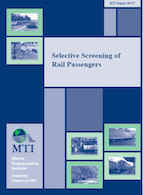- 408-924-7560
- mineta-institute@sjsu.edu
- Donate
How Far, By Which Route, and Why? A Spatial Analysis of Pedestrian Preference
There is an increasing interest in community walkability, as reflected in the growing number of state and federal initiatives on Safe Routes to School, the new concern over a national obesity epidemic, and the rising interest in smart growth and related policy approaches to urban development. In each of these cases, walking is recognized as a key mode of travel, and increasing walking is viewed as a key goal. Despite the seeming simplicity of the goal of building communities that are good places to walk, we actually know very little about how our local infrastructure affects people's willingness or capacity to walk to access their desired destinations. The central research questions for this study are thus: How far do pedestrians walk to rail transit stations? and What environmental factors influence their route choice?.
This research project surveyed people who walked to five rail transit stops to find out what route they walked and their preferences in choosing a walking route. In addition, we conducted an environmental audit of the streets and intersections around those stations. Combing the results from both activities, our analysis generated five key findings about pedestrian behaviors and preferences, including the finding that the average survey respondent walked a half mile, far farther than the quarter to a third of a mile assumed by many to be the maximum distance that Americans will walk. In addition, pedestrians in the study believed that their primary consideration in choosing a route is minimizing time and distance. Secondary factors influencing their route choice were safety from traffic and, to a lesser extent, attractiveness of the route, sidewalk quality, and the absence of long waits at traffic lights..
Through the data collection and analysis process, we developed several recommendations related to the methodology for doing such detailed, block-by-block analysis. Three of these focus on how to reduce the time burden of collecting the data, allowing a research team to hone in on collecting only the most useful data. The final two findings address the practicalities of collecting the data-whether to use Pocket PCs or pen and paper, and the importance of ground testing maps if one uses a GIS-based system running on Pocket PCs.
MARC SCHLOSSBERG, PhD
Dr. Marc Schlossberg is an associate professor within the Department of Planning, Public Policy and Management (PPPM) at the University of Oregon, a research associate of the Mineta Transportation Institute, and an associate director of the Oregon Transportation Research and Education Consortium (OTREC). At this time his teaching, research, and service work fall within bicycle and pedestrian transportation planning and the uses of participatory GIS to facilitate social change.
ASHA WEINSTEIN AGRAWAL, PhD
Dr. Asha Weinstein Agrawal is an assistant professor of Urban and Regional Planning at San Jos State University. Her research and teaching interests in transportation policy and planning include transportation finance, pedestrian planning, and urban street design. She has a BA from Harvard University, an MSc. from the London School of Economics and Political Science, and a PhD from the University of California at Berkeley.
-
Contact Us
San José State University One Washington Square, San Jose, CA 95192 Phone: 408-924-7560 Email: mineta-institute@sjsu.edu






